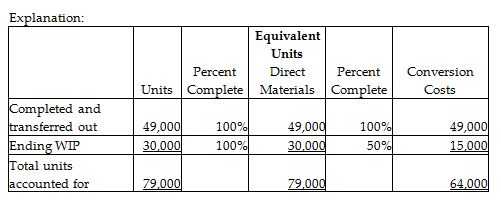The Refining Department of SweetBeet, Inc. had 79,000 tons of sugar to account for in July. Of the 79,000 tons, 49,000 tons were completed and transferred to the Boiling Department, and the remaining 30,000 tons were 50% complete. The materials required for production are added at the beginning of the process. Conversion costs are added evenly throughout the refining process. The weighted-average method is used. Calculate the total equivalent units of production for direct materials.
A) 64,000 units
B) 49,000 units
C) 15,000 units
D) 79,000 units
D) 79,000 units

You might also like to view...
Which of the following questions relates to the place element of the marketing mix?
A. Should I offer customers a discount? B. How do I want the public to view my product? C. How much inventory should I have? D. How long has my product existed? E. Do I need to hire salespeople?
A conflict trigger over information may occur when a manager:
a. Has not been clear in communicating a directive to the team, causing team members to have differing understandings regarding task expectations b. Does not understand why an employee has difficulty speaking up in a team meeting but is forthcoming with communicating her ideas when meeting one-on-one c. Becomes uncomfortable with the political diatribe of an ardently conservative employee d. Must inform the team of a new organizational structure for the division, which may result in a realignment of their roles
Activity flexible budgeting provides a more accurate prediction of costs than a traditional flexible budgeting approach because
A) costs often vary with more than one driver. B) non-unit level drivers are often not highly correlated with direct labor hours. C) direct labor hours are often not measured correctly. D) costs often vary with more than one driver and non-unit level drivers are often not highly correlated with direct labor hours. E) costs often vary with more than one driver and direct labor hours are not correct.
Which of the following statements is true regarding the relationship of law and ethics?
A) In some cases ethics will require a higher standard of conduct than the law, but never vice versa. B) The legal requirement will almost always be the same as the ethical requirement because the law is based on the ethical standards. C) In some cases the law will require a higher standard of conduct than ethics, but never vice versa. D) Depending on the circumstances, the law can require a higher, lower, or the same standard of conduct as ethics demands.